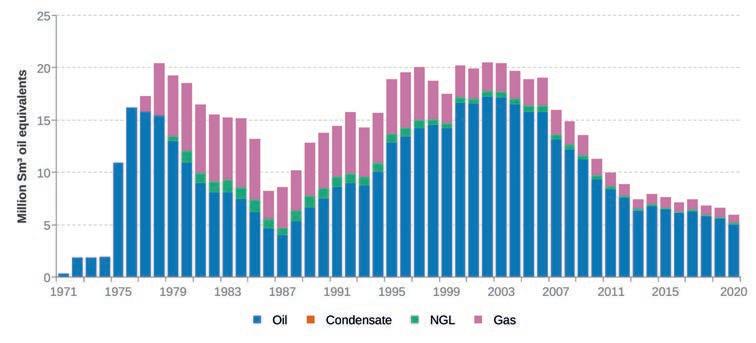
3 minute read
Exceptonal Ekofsk
Exceptional Ekofsk
Since starting production in 1971, Ekofsk has been further developed with many facilities, including facilities for associated felds and export pipelines. Several of the initial facilities have already been removed or are awaiting decommissioning.
Advertisement
Photo courtesy of ConocoPhilips.
THIS YEAR MARKS THE 50TH ANNIVERSARY OF THE EKOFISK FIELD STARTING UP, MAKING NORWAY AN OIL-PRODUCING NATION. DURING this half of a century, the felds on the Norwegian shelf have collectvely produced oil and gas valued at a dizzying USD 1,925 billion.
Ekofsk has been – and remains – an important contributor to this. It’s a story of bright minds and smart methods, which in many ways illustrates Norwegian petroleum history. “The Norwegian Petroleum Directorate congratulates operator ConocoPhillips and the licensees on achieving yet another milestone. Ekofsk must be one of the fnest examples of maximum resource utlisaton through improved recovery measures”, says Director General Ingrid Sølvberg of the Norwegian Petroleum Directorate.
Three billion barrels
Ekofsk is a feld in the southern part of the Norwegian sector in the North Sea. The water depth is 70m. The values come from a reservoir 3,000m below the seabed. More than three billion barrels of oil have been produced so far from the 300m oil column here. If the licensees are able to increase the recovery rate by a few more percentage points, this will have a substantal impact on value creaton from Ekofsk. The feld was discovered in 1969, and the inital plan for development and operaton (PDO) was approved in 1972. Test producton was initated in 1971 and ordinary producton started in 1972. Producton was initally routed to tankships untl a concrete storage tank was installed in 1973. Since then, the feld has been further developed with many facilites, including facilites for associated felds and export pipelines. Gas from the Ekofsk area is transported via the Norpipe gas pipeline to Emden in Germany, while the oil is sent via the Norpipe oil pipeline to Teesside in the UK.
Water injection
The inital feld development started with three producton platorms: Ekofsk A, Ekofsk B, and Ekofsk C. Wellhead platorm Ekofsk X and process platorm Ekofsk J were installed in 1996 and 1998 respectvely as part of the Ekofsk II project. In 2005, wellhead platorm Ekofsk M was installed as part of the Ekofsk Growth Project. Water injecton made a strong contributon towards extending
Source: norskpetroleum.no.

Increasingly better utilisation and development of technology could make it possible to continue production from Ekofsk for decades to come.

producton by more than 30 years so far. A plan for this was approved in 1983. Ekofsk K, which is the main injecton facility, started water injecton in 1987 and is stll in operaton. There had also been water injecton at Ekofsk W from 1989 untl 2009, when Ekofsk W was shut down and replaced by a subsea template, Ekofsk VA.
Continuing production
A PDO for the development of Ekofsk South was approved in 2011. The project included two new installatons in the southern part of the feld: producton platorm Ekofsk Z and a subsea template for water injecton, Ekofsk VB. Injecton from Ekofsk VB and producton from Ekofsk Z started in 2013. The accommodaton facilites Ekofsk H and Ekofsk Q were replaced by Ekofsk L in 2014. An amended PDO for an additonal water injecton template, Ekofsk VC, was approved in 2017. Ms Sølvberg states, “Increasingly beter utlisaton and development of technology could make it possible to contnue producton from Ekofsk for decades to come. The frst feld on the Norwegian contnental shelf could also be one of the last.”
Photo courtesy of ConocoPhillips.










